Imagine being a marketer with a product that pretty much everyone can use. From a small business owner with five employees to a Fortune 100 company, your target market is gigantic. On the surface, it sounds like an easy job, but the reality is marketing a horizontal solution comes with a ton of tough – and exciting – challenges. As the VP of Box, Lauren Vaccarello has a deep understanding of these challenges.
You must always keep in mind that building a marketing strategy that speaks to everyone will only result in a snooze-inducing message that blends in with the rest of the market. Don’t be afraid to do some in-depth customer research to really understand the differences between your customer segments. You should also be vigilant about getting marketing team aligned with sales because the success of both departments is dependent on each other.
Listen to Lauren’s talk for more about effectively marketing to small, medium, large and extra large customers.
You can view the slide deck here.
And if you haven’t heard: SaaStr Annual will be back in 2018, bigger and better than ever! Join 10,000 fellow founders, investors and execs for 3 days of unparalleled networking and epic learnings from SaaS legends like Jyoti Bansal, Aaron Levie, Josh James, and Dustin Moskovitz. If you don’t have tickets, lock in Early Bird pricing today and bring your team from just $649! (Prices go up August 1st.) Get tickets here.
TRANSCRIPT
Lauren Vaccarello: Hey, everybody. I’m really impressed that I managed not to trip up the stairs, so we’re starting off well.
Today, we’re going to talk about how to market to customers small, medium, large, and extra large, all at the same time, from the same budget.
Quick question so I can get an idea of who’s in the room. Who here works at a company, let’s say, less than $10 million in ARR? Who here has this problem where everyone can be your customer? Just making sure we’re in the right room.
Let’s talk about what we’re going to talk about today. I’m going to talk a little bit about me. You’re only going to get 30 seconds about why I’m up here, why I’m on stage.
I’m going to talk a little bit about Box. It’s the reason that I’m allowed to be here today. We’re going to talk about what it’s like to have a product that everyone and anyone can use.
Then, most importantly, we’re going to get to the meat of the presentation, which is going to be the 10 things you need to know to successfully market to businesses of all sizes.
Who am I, and why am I here? Super quick, like we said, I’m Lauren Vaccarello. I’m VP of Marketing at Box.
What that means is I have the hodgepodge of the marketing department, a ton of performance marketing, a website, field marketing, events, operations, brand, really interesting group, really interesting team.
Prior to that, I worked at AdRoll, where I ran global marketing. Most notably, I ran digital acquisition at Salesforce.
I wrote a couple of books on B2B digital marketing. My best friend likes to tell me any time her daughter can’t sleep, she busts these out to help with that, [laughs] so if any of you have small children, these are great assets for you.
Who is Box? Box is a modern content management platform that transforms how organizations work. It’s a really good statement, isn’t it? The marketing team wrote that. [laughs]
What’s interesting about Box is we have 69,000 customers and over 60 percent of the Fortune 500.
How many people in here are marketers? I know marketers, myself included, aren’t always that good at math, but 60 percent of the Fortune 500 and 69,000 customers doesn’t seem to add up. 60 percent of the Fortune 500 is a lot less than 69,000, so how do we actually do this?
The thing about Box is everyone can use my product. This means the Fortune 500 can use my product. This also means that small, five person ad agencies can use my product, which is great.
Also, between Salesforce, between AdRoll, through most of my career in Silicon Valley, I’ve worked for companies that’s had this challenge. Everyone and anyone can use your product. It’s this fantastic horizontal solution.
You can have GE using your product. You can have Webcor using your product, which is building all the buildings in downtown San Francisco. Every industry can use your product. Every department can use your product. It’s a marketer’s dream, right? Super easy. Anyone can use your product. This should be shooting fish in the barrel, right?
Here’s the problem with when everyone and anyone can use your product. This is one of the most likely things you’re going to get. It’s fine. It’s a couch. It’s fine. It’s perfectly comfortable, but it’s beige.
When you start to build a marketing strategy to market to everyone and anyone at the exact same time, this is what most companies get. This is what most companies unfortunately end up building.
You’re going to build messaging that makes sense for everybody. You’re going to use go to market strategies that make sense for pretty much everybody.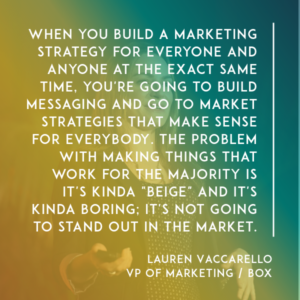
The problem with making things that work for the majority is it’s kinda beige and it’s kinda boring, and it’s really not going to stand out in the market. Ultimately, how do we solve for this? There’s 10 things you need to know to start to solve for this.
The first one, and it really all lines up to customer segmentation. Whenever you’re thinking about, “How do I solve this gigantic challenge? Everyone and everyone can use my product,” always anchor on customer segmentation.
What I’m really going to talk about anchors along the lines of, “How do you segment to company size?” Depending on your business, your segmentation strategy may be a little bit different, but for most companies, when you’re just starting off, figuring out how to do this, anchor on your sales segments.
The first thing you need to know is how do you align with your sales organization? When we’re talking about how do you align with your sales organization, what do we really mean with that?
How many people here are in sales? How many of the salespeople here sit down with their marketing leader every single day? Weekly? Monthly? Never? How many people don’t really like their marketing counterpart or their sales counterpart?
[laughter]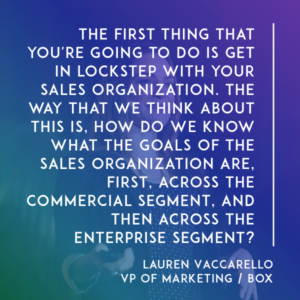
Lauren: That never happens, right? The first thing that you’re going to do if you want to market to businesses of all sizes is get in lockstep with your sales organization. The way that we think about this is, how do we know what the goals of the sales organization is, first, across the commercial segment, and then across the enterprise segment?
Are you going after net new customers, or are you going after customer upsell? What are the verticals you’re going after? What are the geos you’re going after?
You need to make sure both sales knows what the targets are and the marketing department knows what the targets are. It’s really easy for marketing to be order takers for the sales department. The way we really set this up is, “How do we come up with this together? How do we come up with targets together, and what we want to do as a collective unit?”
Next up is, “How do we set targets by segments?” One of the models that we had used at Salesforce that we employ at Box and at other companies is this concept of the four horsemen. It’s the idea of annual recurring revenue pipeline is not just dependent on the sales team. It really is across all of go to market.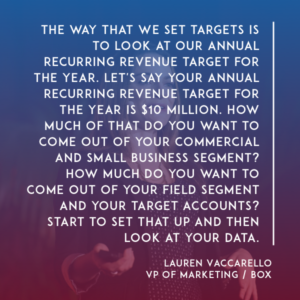
The way that we start to set targets are you look at what is your annual recurring revenue target for the year. Let’s say, your annual recurring revenue target for the year is $10 million. You want to generate $10 million of revenue.
How much of that do you want to come out of your commercial segment, your small business? How much do you want to come out of your field segment and your target accounts? Start to set that up, and then look at your data.
How long is your sales cycle? What does your win rate need to be? Don’t look at blended averages. Look at across your different segments, what your sales cycle is, what your win rate is, and what your pipeline coverage is.
Let’s say, in commercial, you want to generate $5 million in annual recurring revenue. You need your 3:1 coverage ratio. That means you need $15 million. How do you start pacing that out?
Once you get those numbers of how you start pacing out your annual recurring revenue and how much pipeline you need, then you can walk through and start assigning targets across marketing, across sales, across channel and alliances.
Some good basic numbers to keep in the back of your mind, if you’re thinking of small business, if you’re thinking of companies 100 and under, with the marketing organization, marketing tends to be responsible for about 50 to 60 percent of source pipeline and pipeline generation across a company size under 100.
From 100 to 1000, marketing should be responsible for about 20 to 30 percent. If you were going after your direct sales, your enterprise accounts, marketing typically is responsible for about 10 percent of source pipeline, of pipeline coming in the door.
I didn’t make this up. This is actually SiriusDecisions, but it is also based in reality. I will do a quick aside. I’ve never been told I only have to generate 10 percent of pipeline for sales. [laughs]
I love that idea. Even in the upper end of the market, I’m coming in 15 to 20, but if anyone from Box sales is in here, SiriusDecisions says I only need 10 percent, and I’m killing it.
Start to set these targets by segment, and make sure sales and marketing agrees. Super basic, assign a segment lead in your marketing team.
When I got to Box, our mid market segment, sort of in the middle between your small business and your enterprise, wasn’t doing that well in terms of marketing’s contribution to the business.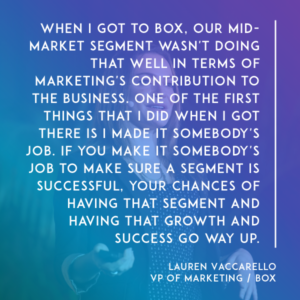
One of the first things that I did when I got there is I made it somebody’s job. If you make it somebody’s job to make sure a segment is successful, your chances of having that segment and having that growth and that part of the business being successful goes way up.
If you don’t know what to do, make this somebody’s job. Put someone in your marketing team in charge of growing the commercial side of your business and in charge of growing the field side of the business. Even if they don’t own all of the tactics, they have to own the strategy, and they have to build it out.
Then you start thinking about how you build segment specific messaging. You’re aligned with sales, you know who you’re going after, you know exactly what your targets are, you have somebody in charge of it. You say, “Joyce, your target is $15 million. Carol, your target is $20 million. This is what I need you to go do. Start to build your programs.”
After you have that, you can have all the right infrastructure, but if you start using the same content and the same messaging, you’re going to get that ugly beige couch again. It doesn’t matter if you have the right strategy, if your messaging is the same across segment, you’re going to start to miss.
How do you build your messaging strategy for the business? This is a really, really simple chart. If you’re just starting to build out your marketing program, this is a great worksheet to start filling out as you’re thinking through it.
Sit down across small business and across large enterprise, and think about who your ideal customer is. Now, I know nobody in here would do this, but I’m just going to call it out. This should not be done by a bunch of marketers sitting in a room, making all of this up.
The way you’re really going to build out your messaging strategy, figure out who your ideal customer is, do a little research. Talk to customers. Talk to your sales org. Talk to your customer success organization, the people who are really in it with customers every day.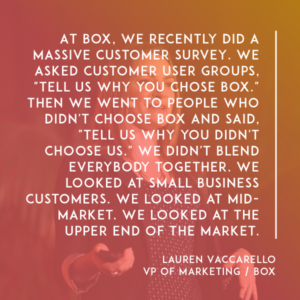
When we built this out at Box recently, we did a massive customer survey. We did customer user groups, and started to sit down and say, “Tell us why you chose Box.” Then we went to people who didn’t choose Box and said, “Tell us why you didn’t choose us. What are you really looking for? What are the problems you’re trying to solve?”
We didn’t look and blend everybody together. We looked at small business customers. We looked at mid market for us. We looked at the upper end of the market and started to understand, “What are the problems they’re solving? What are they really looking for?” and we started to fill this out.
“What are your objectives? What’s the infrastructure you’re using? Really importantly, what are those buying triggers? What makes now imperative?” The thing that is not on this, that should be on this, is customer proof points.
When you are building your messaging strategy, make sure you have customer proof points, customer stories, customer evidence across small business, and then also across the enterprise.
If you’re a 25 person ad agency, having a case study from GE isn’t that relevant for you. You assume they don’t serve your business, so be really, really careful about the customers you reference based on customer segment.
Your technology and your automation is going to be key. With small businesses, the great thing about being able to go after the millions of small businesses that exist in North America is you’ve got this massive target audience. The downside of this is it’s really hard to have any sort of high touch interaction.
Building out the right technology, the right automation, and the right programmatic marketing is going to be key for small business. Think of this as really, really heavy digital.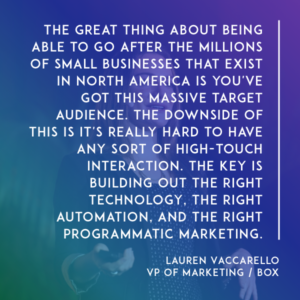
A couple of my favorite pieces of technology that are on the market right now, just to start building this up. There’s a couple that aren’t on here that I’ll also talk about.
Demandbase or Radius Intelligence for company intelligence reverse IP lookup. The reason that’s going to be really important is how you start to target and segment your website.
Predictive analytics is a very, very hot topic right now in the marketing world. You’ll probably hear a lot about it over the next couple of days. What predictive analytics is going to let you do is figure out who to target and when, who’s showing intent in the market.
If you can go after 50,000 customers right now, and you have a 15 person sales organization, how do you help prioritize this? They are going to drown in how big their territory is. Your predictive analytic solutions will help you solve a lot of that.
Marketo Sales Insight’s really interesting right now. It will start to highlight with your sales people who’s doing what, what else they’re doing. Engagio also has a really good solution for this right now, so if you don’t have Marketo, Engagio account analytics will let you and your salespeople see these intent signals, who’s in the market to buy and when.
I love Optimizely. I think it’s an awesome tool for personalization and experimentation on your website. If you’re just getting into personalization and web optimization, start really simple with Optimizely, build out a couple of tests. We’ll talk a little bit more about it.
Conductor’s great for SEO. There’s a lot of in app messaging tools. When you’re thinking about marketing, don’t just think about, “Let me send an email. Let me throw up some Facebook Ads, do some programmatic advertising.” Once you get someone inside your trial experience, you’re in app messaging is really, really interesting.
Engagio also has another solution called Sales PlayMaker that you can start to do programmatic sales plays. These are the actions you want your sales team to take, and they literally just click buttons and customize content. It’s a great way to build scale quickly.
There’s another tool out there called Conversica, which is artificial intelligence for lead management. Instead of relying on your SDRs to send out tons of emails for every lead, you can start to prime the pump with a little bit of AI, figure out who’s in the market right now, to let your sales organization really focus.
Next up, you need a great trial experience. We are dependent on product organizations in a lot of ways to build a great trial experience, but having a great trial experience is going to be completely, completely pivotal.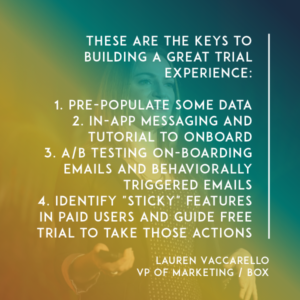
Some basics on building a great trial experience that we went through at Salesforce and then again at Box, first thing for a basic trial experience, if you can work with your product team on this, just pre populate some data. It’s really overwhelming to walk into an empty free trial, so pre populate some sample data.
Again, think about that in app messaging and how you can use tutorials to onboard. When you’re thinking about, “What do I want to say in in-app messaging? How do I onboard?” Best way to do that and to figure that out is look at the data that you have.
What actions? What do you want someone to do that makes your product really, really sticky? At Salesforce, we had found that uploading contacts and building a dashboard was what made products sticky, and this was Salesforce eight years ago when it was not the category leader. It was a much smaller company.
We said, “How do we make this product really sticky?” So, looked at product usage. “What are the attributes of a customer who doesn’t leave? Let’s bake that into the trial experience. Let’s make the trial experience start to walk you through these actions that indicate product stickiness.”
Going even deeper on that, “How do you build a great trial? How do you actually nurture your leads all the way through the funnel?” Lead nurturing is not just about email. Lead nurturing goes beyond sort of your basic email marketing. When you’re thinking about lead nurturing, you’re thinking about programmatic onboarding.
Just a couple of quick tips. Again, I’m super into in app messaging right now if you can’t tell. The other piece is time product usage into marketing automation data. What I’ve seen at a lot of companies is your marketing automation data lives here, you’re going to send a bunch of emails that are based on, “They opened this email and this is what they said.”
Over here, you have product usage. People are taking these actions in product, and there’s no connection between the two.
If you really want to speed up lead nurturing, if you really want to speed up time to close and win rates, think about how you can use technology to tie together your onboarding, all of your product usage data, what people are doing, how they’re interacting…
[fire engine sound]
Lauren: …with a fire engine, [laughs] with also what content they’re engaging with on your website, with what emails they’re interacting, and really tie these two different areas together.
Again, super basic,but something that we all forget as marketers, is as you’re onboarding, as you’re nurturing leads through the funnel, we need to keep the sales organization tied in because all of the marketing touch points also interact with all of the sales touch points.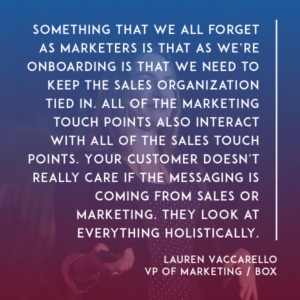
The end user, your customer, your prospect, doesn’t really care if the messaging’s coming from sales, the messaging’s coming from marketing. They look at everything very holistically, so it’s our jobs to make sure that we are thinking about the full funnel.
Again, the Engagio’s tool for account analytics will start to bubble up what the marketing activities are in an environment that your sales team can see so they can start to plan accordingly, and they get that understanding of how things really work together.
We talked a lot about small business, and what we’re going to do to drive marketing at breadth. This is where things are going to get a little bit different. When you’re targeting up market, what we’re finding right now, targeting up market, targeting the Fortune 1000, targeting the Fortune 500, or whatever your high potential revenue customers are, a lot of the tactics are different.
I’ve had great conversations with people in the last couple of weeks on, “How does this work? Our model is different. We really are only going after 500 companies. SEM’s not really working for me. Facebook ads aren’t working.”
All of these things that have worked historically in the last 10 or 15 years on how you drive scale just doesn’t seem to be working anymore, and doesn’t seem to be working when you’re targeting the enterprise.
Honestly, the market’s shifted. The market’s shifted for any sort of upmarket communication, so when we are going after our high touch, high value accounts, we employ a totally different strategy. It really is this account based everything.
You hear a lot about account based marketing and account based selling. We look at it as, “How do we think about account based everything?”
The way we approach this at Box, we’re about a year or so into this shift to targeting the enterprise into this account based everything model. The way we approached it was, again, really holistically with our sales leadership organization.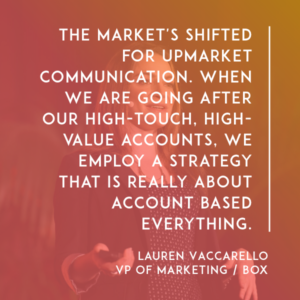
We sat down with our data science team to start off and said, “Who are the accounts we should go after? Come back to us, and tell us what’s going on. What are the accounts with the highest total addressable market? What are the accounts that we think we’ll have the highest likelihood of buying? What are we successful?”
We had this incredibly smart data science team come back and give us a ton of accounts. We sat down with the sales organization and said, “All right, who do you guys think we should go after?” and came up with that list.
We found when we combine the list from the data science team and the list from the sales organization, we get an incremental uptick of a win rate of about 10 or 15 percent when combining the two different groups, so not just the data list and not just the sales list but really putting these things together and coming up with what our target list is.
We did this at Salesforce about eight years ago on the SE 1,000, which was the top thousand accounts to go after. It’s roughly a similar size at Box right now. We came up with this targeted list.
What we’re actually looking to do this year is, we have the data, we have the alignment across sales, and to help prioritize that thousand accounts, we’re pulling in intense signals.
We’re pulling a lot of that predictive intelligence and saying, “Here’s the thousand accounts that sales and marketing are going to go after together.” It’s still a lot of accounts to prioritize, so we’re using predictive analytics to pull out and say, “What are the 50 most active accounts right now? Who’s in market? Who’s paying attention? Who’s listening? How do we make sure we’re going after them right this minute?”
Just a couple of sample account based marketing plays for you to think through as you’re building your top of market strategy. First one, going after net new customers. You’re going to employ slightly different strategies for net new customers versus your land and expands, versus your customer upsells.
For us, net new customers, sat down with the sales organization and said, “These are the accounts we’re going after together across sales and marketing. Perfect.
“Marketing’s job is to provide as much air cover as possible. We’re going to use targeted digital advertising, just going after these companies.” There’s a lot of really cool stuff that you can do right now…I almost cursed. [laughs]
There’s a lot of really cool stuff you can do right now with custom audiences. How do you take business email addresses, match it with their personal email addresses, and then build custom audiences across Google’s network and Facebook’s network to go after, to be in front of your exact target audience?
We’ve done a ton of account profiling. We also do a lot of event targeting. This is where it gets really interesting going up market. I’ve been in the digital marketing space for 15 years. 15 years ago, I would have never said, “Events work.” I would have never said, “Field marketing works.” I would have laughed at direct mail. Actually, I did laugh at direct mail.
Now, 15 years later, the things that are working really, really well, going up market, the occasional direct mail piece, field marketing, and throwing events like this. The industry has really come full circle, [laughs] and now I will tell you how incredible events are.
If you have event sponsorships, if you are sponsoring events like SaaStr or industry events, you can ask the event company to invite certain people to the event, which is a really, really interesting tactic to say, “SaaStr, we want to get in front of Box. Can you invite these five people from Box to the event, and could you help facilitate an introduction?” It’s not you reaching out to a potential prospect. It’s coming from a third party.
We’ve also worked on appointment setting, and this is, “How do we get warm bodies in front of our sales organization so they can go and start talking and selling to net new?”
We also started to think about, “What do we do when we have low penetration in an account?” We’ve got a couple of seats. The great thing about Box, if you have a 10,000 person company, 10,000 people can use our product.
Sometimes, only five people in a department use it. What do we want to do with that sort of a deployment? We want to go in market, figure out who those five people are, and really get full penetration within a company.
Your strategy’s going to be a little bit different. You’re still going to do digital. You’re still going to do events, but you’re going to pull in your outbound sales reps and do outbound rep activities. You’re going do these really prescriptive sales plays with the sales organization.
Your executive and hospitality events go really well. Don’t underestimate the value of your peer to peer outreach.
If you’re looking for a real customer upsell, customer cross sell, we have a lot heavier AE engagement, a lot heavier customer success, and then really bringing in that executive relationship. We built these prescriptive plans across the board.
Again, for our account based marketing program, our field marketing and that sort of hand to hand combat, getting in front of large accounts, is one of the most, I don’t want to say profitable, but it really is profitable activities for us right now.
Two seconds about overlap. Everyone uses the Internet. Small businesses use the Internet. Large businesses use the Internet. I’ve had to have this conversation with people that I work for, who assume the only people that are ever going to click on an ad on the Internet or visit your website are a small business. You can be the CEO of a Fortune 10 company, you’re going to use the Internet.
What happens when there’s that overlap? What happens when you’re starting to build out a lot of your digital content, you’re focusing on the lowest end of the market, but your product’s for everybody?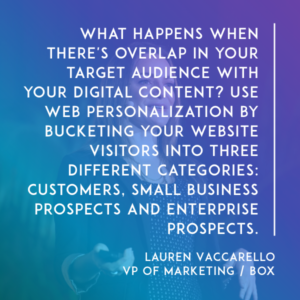
Really simple Web personalization that you can turn on today, Salesforce does it really well, so I always use them as the example. Start to bucket your website visitors into three different categories.
One, are they customers, or are they prospects? Have a customer version of your website, so anytime a customer comes to the website, you cross sell, you upsell, you engage them, you get them to use your product.
Really easy to set up. You can use it with Optimizely. You basically just read their cookie. If they’re a customer, you serve them that version. If they’re a prospect, the whole version of your website is to get them to buy your product.
Within the prospect part of your customers, you’re then going to split it two ways, your small business customers and your enterprise customers. This is where a company like Demandbase comes into play.
Demandbase is reverse IP lookup. You can figure out what companies are coming to your website. One of the biggest complaints about Demandbase is your match rate’s 15-20 percent. “What about the other 80? We’re just doing personalization for 15 percent.” Flip the way you’re thinking about that.
If you can identify 15 percent of the people coming to your website, assume those are probably going to be the largest companies, because they have dedicated IP addresses.
The 85 percent of people that come to your website that you don’t know their company size, assume they’re small businesses, that they can’t afford or they don’t have the volume for a dedicated IP address.
For your prospect version of your website, if you don’t know who they are, serve them up that small business messaging to try to get them in the door. If you know who they are, and they’re a large company, tailor your messaging to much larger upmarket messaging.
Finally, the role of marketing doesn’t end at purchase. Part of me wishes we still lived in a world where our entire job was just to send leads to sales, but that’s not actually going to drive revenue. Think about marketing and what the role of marketing is going to be ongoing.
For us, it’s, “How do you create a month one and a year one engagement plan?” We want to get people in the door, but we want to make sure they’re customers, they’re happy customers, and they are really customers for life.
For us, it is, “How do you start to think about driving net retention?” Your net retention is going to look at, “How much are you making off a customer today?” Subtract churn, and then add in upsell and cross sell. Building this year one, month one onboarding plan and year one engagement plan is going to help with that.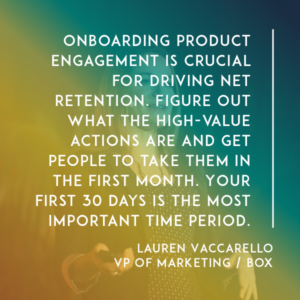
Super quick on how to drive net retention. Again, your onboarding product engagement is crucial. Figure out what those high value actions are, and get people to take them in the first month. Your first 30 days is the most important time period you have for customers.
You can do it programmatically. You can do it with the CS organization. Honestly, onboard them with both. This is really a joint responsibility across sales, marketing, CS, product.
I’m just about done. A couple of key takeaways. It’s great that you can market to anybody, and everyone’s your customer. Just build out your segmented base strategies. Tailor your messaging. High tech, low touch for small business. Whatever you can automate, think about how you can automate.
In enterprise, what’s old is new. The high touch field marketing hand to hand combat is going to be your most successful tactics right now. Don’t forget to onboard and retain your customers. It’s a lot easier to keep customers than it is to acquire new ones.
Hopefully, that was helpful for everyone, you got a lot of stuff and things you could walk away with. Thank you very, very much. I’m Lauren Vaccarello. I’m around all week.
See Lauren’s slides here.

